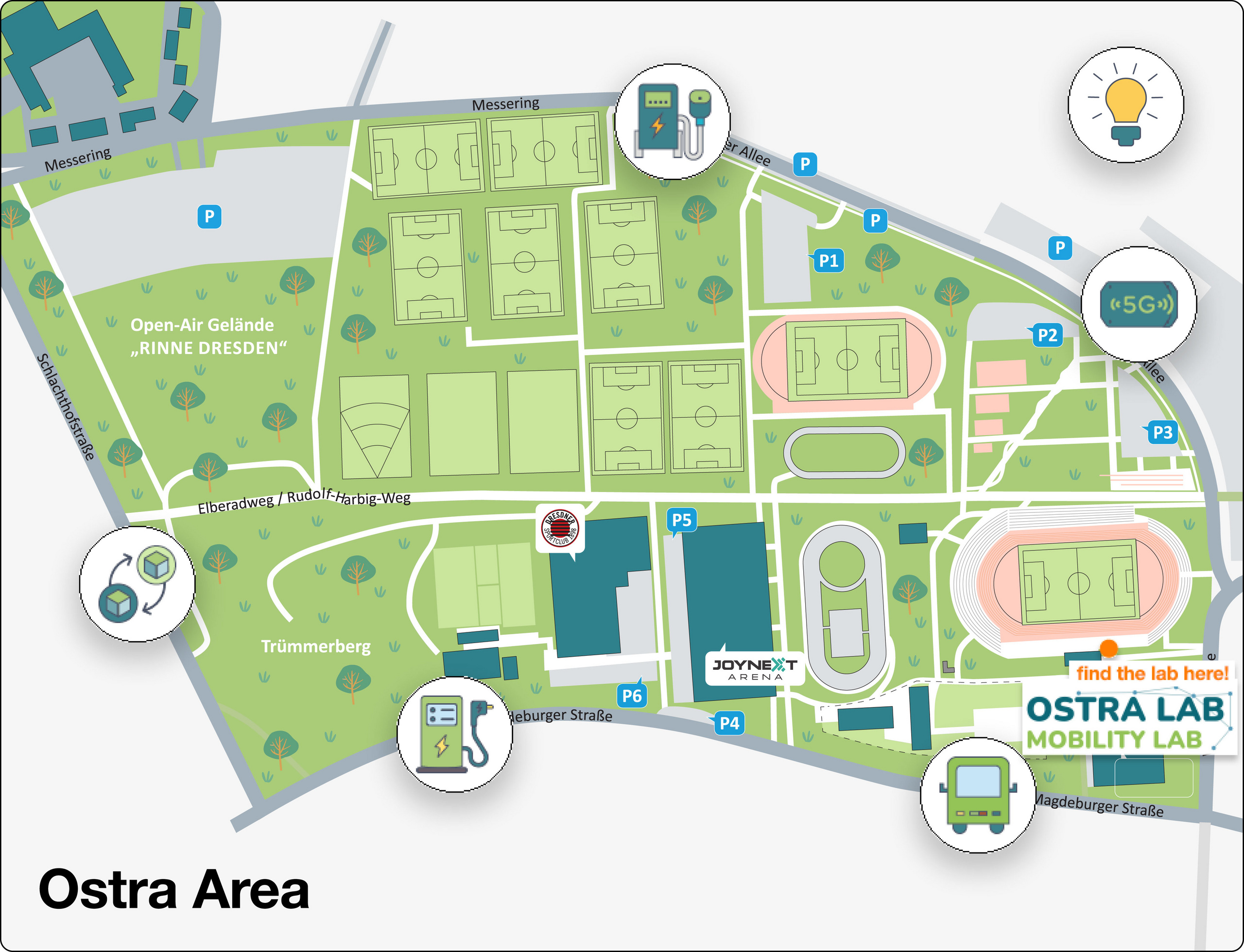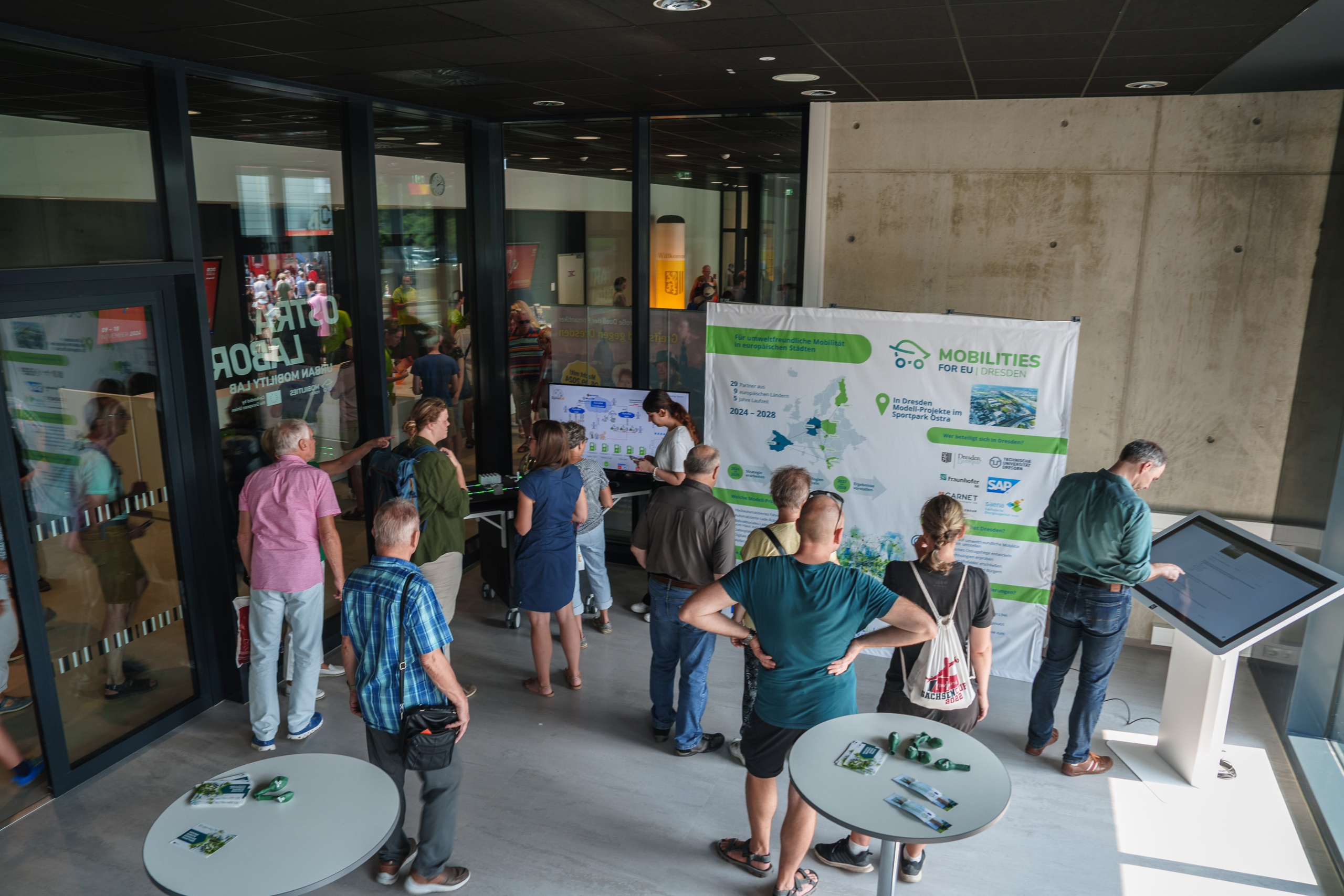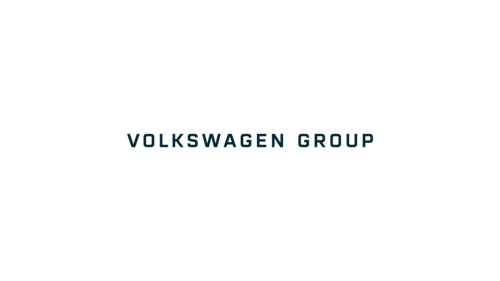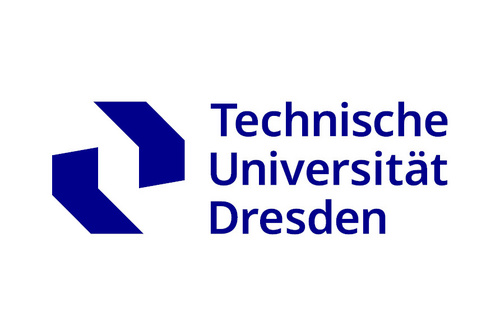MOBILITIES for EU
Test field for future-proof transport structures and sustainable mobility in Ostragehege and northern Friedrichstadt


Test field for future-proof transport structures and sustainable mobility in Ostragehege and northern Friedrichstadt


MOBILITIES FOR EU is developing innovative mobility solutions in Dresden, such as a parking guidance system and mobile charging robots, to make the traffic situation more environmentally friendly and flexible and to serve as a model for other European cities.
The aim of the project is to create a test field for the mobility of the future in Dresden, with a focus on sustainable transport, smart technologies such as 5G communication and integrated mobility concepts to improve urban transport and accessibility for all.


The "MOBILITIES for EU" project is creating a pioneering testing ground for the mobility of the future in Dresden's Ostragehege and Nördliche Friedrichstadt. In this multi-purpose area, which combines sports facilities, the Flutrinne event venue and the Dresden trade fair, the state capital is working with various partners to develop innovative solutions to improve transportation and sustainability. The pilot projects include charging robots for innovative e-charging, automated networked driving and optimization and control via a 5G communication network. In addition, an intermodal mobility concept is being integrated to increase safety for cyclists and pedestrians. With these measures, Dresden is taking on a pioneering role in urban mobility development and shaping the mobility of tomorrow. The OSTRA laboratory in the Heinz Steyer Stadium offers a place for the exchange and further development of these ideas.

The Ostragehege is an important sports and event area with 28 sports venues, including the Heinz Steyer Stadium, the JoyNext Arena and other multifunctional areas such as the trade fair Dresden. Particular challenges include its location in a flood zone, which makes it difficult to install conventional charging points, and the dynamic traffic volume: Major events result in heavy traffic jams and chaotic parking situations, while everyday traffic is light. The MOBILITIES FOR EU project addresses these problems by developing innovative solutions such as mobile charging stations, optimized parking guidance systems and intermodal traffic concepts. The aim is to make the area more sustainable, resilient and attractive.

The further development of existing mobility services in Dresden, supported by communication via the 5G network and integrated data platforms, contributes to an improved traffic situation and the promotion of intermodal mobility. Sharing services will become more accessible and safe infrastructure for cycling and walking will strengthen active mobility. Barrier-free autonomous shuttles improve connections to the city center and reduce the shortage of parking spaces, supported by an intelligent traffic and parking guidance system. Mobile charging robots also make it possible to charge electric vehicles in the flood channel. The seamless networking of all components will create a more efficient, sustainable transport system.

The heart of Dresden's participation in the EU project MOBILITIES FOR EU is the Ostra-Lab for Urban Mobility located in the project area. This innovation hub will promote cooperation between citizens, industry, science and administration in order to shape the future development of mobility. The aim is to create accessible options that bring people together regardless of their personal abilities, ensuring inclusive and collaborative progress. Beyond the project duration, the lab will further develop Dresden's transportation system and position the city as a pioneer for sustainable urban mobility.


Climate-neutral urban development is the challenge of our time and requires the commitment, participation and willingness to invest of all relevant stakeholders in urban society. At the same time, this task presents an opportunity for innovation to actively participate in the dialog on shaping sustainable transport development. Dresden companies can thus seize the opportunity to develop new business models, products and services for urban society. Together with the project partners and associated Dresden companies, we are closely integrating the project results into the local infrastructure. More information about our partners can be found further down on this website.

The measures include innovative and flexible e-charging using charging robots, as well as infrastructure-supported, automated and networked driving with the help of control centers and a mobility data space. Concepts for traffic, transportation and operator solutions are also being developed, accompanied by the establishment of new business models. There is also a focus on the electrification and automation of local public transport. A service& data platform with open interfaces enables dynamic function development and the integration of partner applications. Finally, power grid-based optimization and control via the 5G mobile network is also being driven forward.

As part of the EU initiative "100 climate-neutral and smart cities by 2030" (EU Urban Mission for short), MOBILITIES FOR EU aims to find ways to transition to environmentally friendly urban mobility in European cities. This is to be achieved with the help of concepts for passenger and freight transport that are energy-efficient and user-oriented.

The main focus of the Fraunhofer IVI is the development and prototypical implementation of infrastructure-assisted connected driving via digital infrastructure, control center functionalities and mobility data space technologies.

Volkswagen Group Innovation will develop, build and test two autonomous charging robots. The robots have a battery capacity of 55 kWh and are designed so that the charging plug can be inserted manually and autonomously. The charging robots can be used wherever it is structurally and economically impossible to install a fixed charging station.

The SAP Business Technology Platform is used as a data platform in the project. On this basis, SAP integrates partner applications and various data sources in order to optimize areas such as event management and traffic control with the help of artificial intelligence.

Develops the OSTRA laboratory in Dresden, in which measures for intelligent mobility solutions are defined and interest groups are involved. In addition, SAENA analyzes the social aspects of mobility solutions by conducting surveys in order to transfer them to other application areas and cities.

As a key player in the "MOBILITIES for EU" project, TU Dresden is driving innovation in the field of urban mobility. By implementing advanced 5G networks and bidirectional charging systems in two important pilot projects, TU Dresden is committed to sustainability and climate neutrality.

This project was funded by the European Union as part of its Horizon Europe research framework program.